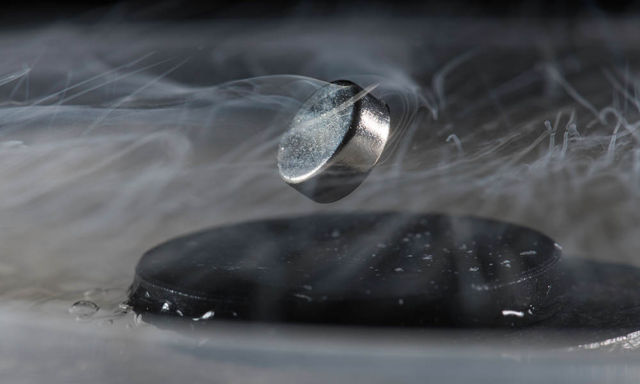For the first time scientists created material that is superconducting at room temperature.
Compressing simple molecular solids with hydrogen at extremely high pressures, University of Rochester engineers and physicists have, for the first time, created material that is superconducting at room temperature.
The goal of new research led by Ranga Dias, assistant professor of mechanical engineering and of physics and astronomy, is to develop superconducting materials at room temperatures. Currently, extreme cold is required to achieve superconductivity, as demonstrated in this photo from Dias’s lab, in which a magnet floats above a superconductor cooled with liquid nitrogen. Credit University of Rochester photo / J. Adam Fenster
Applications include:
-Power grids that transmit electricity without the loss of up to 200 million megawatt hours (MWh) of the energy that now occurs due to resistance in the wires
-A new way to propel levitated trains and other forms of transportation
-Medical imaging and scanning techniques such as MRI and magnetocardiography
-Faster, more efficient electronics for digital logic and memory device technology
Featured as the cover article in the journal Nature, the work was conducted by the lab of Ranga Dias, an assistant professor of mechanical engineering and of physics and astronomy.
Dias says developing materials that are superconducting—without electrical resistance and expulsion of magnetic field at room temperature—is the “holy grail” of condensed matter physics. Sought for more than a century, such materials “can definitely change the world as we know it,” Dias says.
In setting the new record, Dias and his research team combined hydrogen with carbon and sulfur to photochemically synthesize simple organic-derived carbonaceous sulfur hydride in a diamond anvil cell, a research device used to examine miniscule amounts of materials under extraordinarily high pressure.
The carbonaceous sulfur hydride exhibited superconductivity at about 58 degrees Fahrenheit and a pressure of about 267 billion pascals, about a million times higher than a typical automobile tire pressure. This is the first time that superconducting material has been observed at room temperatures.
Dias, who is also affiliated with the University’s materials science and high-energy-density physics programs, explains:
“Because of the limits of low temperature, materials with such extraordinary properties have not quite transformed the world in the way that many might have imagined. However, our discovery will break down these barriers and open the door to many potential applications.”
source University of Rochester






Leave A Comment